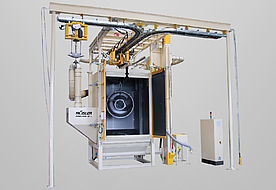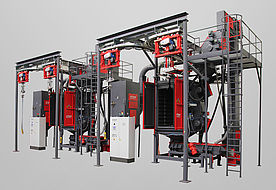
Forge & Foundry, Part 3 – Shot Blasting & Sand Castings
, roslerusa - Volver a la vista general
Our Forge and Foundry Series continues with a deeper look at sand castings. While more than 60 percent of all metal castings are made with a sand casting process, the specific shot blasting machines used to remove surface contaminants vary. Rosler Metal Finishing is uniquely qualified to identify the right shot blasting machine for your process and can help determine what settings and media will produce the best results with every cycle.
Sand Casting Basics
Sand casting, also known as sand molded casting,
is a metal casting process using different kinds of sand as mold material. The
sand is usually “glued” together with a bonding agent like clay, water, oil,
resin, or sodium silicate.
A sand mold consists of two or more sections.
Liquid metal is poured into the cavities formed by the mold.
Once cooled, sand molds pass through a shakeout
device, where they are destroyed to extract the metal castings. The raw
castings then undergo a fettling procedure, where sprews, gates, runners, and
risers are separated, and coarse burs are removed.
The actual castings still contain surface
contaminants in the form of adhering molding sand, sand cores, and scale/rust
(oxidized metal) which must be completely removed before they can undergo
downstream manufacturing operations like machining, surface refinement (edge
radiusing, smoothing, polishing), coating, or painting.
Leaving these contaminants on the castings would
make downstream operations very expensive or outright impossible by, for
example, destroying milling tools and drill bits, quickly polluting coolant
systems, and preventing coatings and paint from adhering to the component
surface.
Efficiency of Shot
Blasting

Shot blasting is the only surface treatment method
for cleaning sand castings due to its versatility, high productivity, and cost
efficiency. It is excellent for all-around de-sanding, descaling/de-rusting,
and even light deburring.
Shot blasting can handle practically any part, from
the smallest to the largest, irrespective of weight and shape. Its efficiency
goes beyond cleaning to produce surface texturing/roughening as preparation for
coating and painting as well. And in the form of shot peening, it will increase
the service life of critical components exposed to tensile and bending stress.
Turbine technology is the predominant blast system used for foundry applications. The large blast pattern of turbines allows effective cleaning of huge work piece surface areas in a highly productive and cost-efficient manner. Air and wet blasting are primarily used for special applications like shot peening or blast cleaning of very delicate parts with thin walls.

While Rosler offers versatile and adaptive mass finishing machines, these machines are used primarily as a surface refinement technology for deburring, defined edge radiusing, surface smoothing, polishing, etc. Theoretically, mass finishing could also be used for cleaning of raw sand castings, but it would be very slow, cost-prohibitive, and only useful with small- to mid-size castings.
The Rosler Way
At Rosler, we know the foundry industry, sand casting, and which techniques provide the best surface finishing. Our shot blasting machines are designed to meet your work piece needs for consistent, dependable results. Whatever sand castings your process includes, Rosler Metal Finishing can learn about your challenges to develop and deliver a solution. Contact us today to discuss your unique challenges.
The complete Forge & Foundry Series includes:
- Part 1 – Shot Blasting Systems.
- Part 2 – Efficient Recycling.
- Part 3 – Shot Blasting & Sand Castings.
- Part 4 – Selecting a Shot Blasting Machine for Sand Castings.
- Part 5 – Cleaning Features & Dust Precautions for Sand Castings.
- Part 6 – Selecting a Shot Blasting Machine for Die Castings.
- Part 7 – Selecting a Shot Blasting Machine for Forgings, Non-Sand Castings, and Powdered Metal Components.
- Part 8 – Frequently Used Shot Blasting Machines for Sand Castings.
- Part 9 – Frequently Used Shot Blasting Machines for Forgings, Non-Sand Castings, and Powdered Metal Components.
- Part 10 – Shot Blasting Machines Commonly Used for Die Castings.
- Part 11 – Top Mass Finishing machines for Cleaning Die Castings
- Part 12 – Media and Compound Selection, Effluent Handling Drive Success
Sign up for enews alerts to be notified of all Rosler blog posts!


